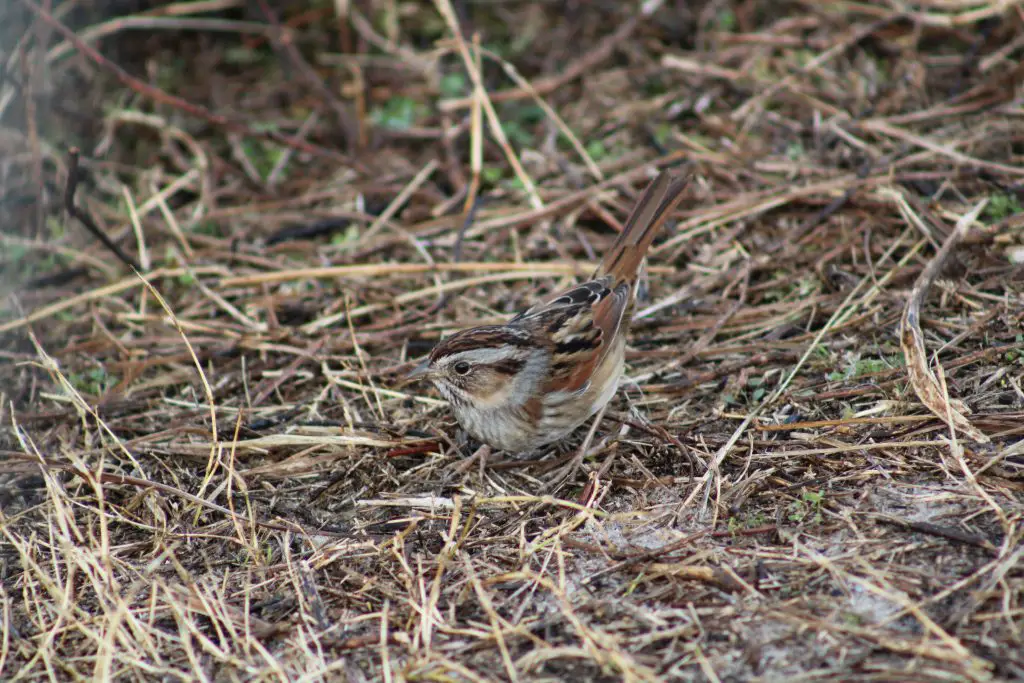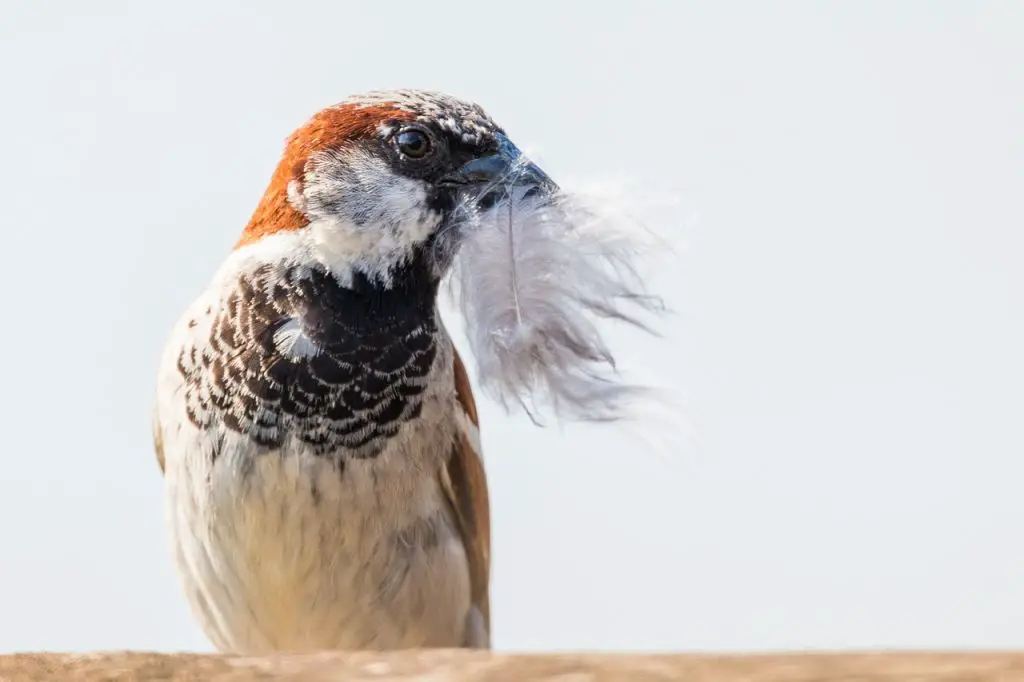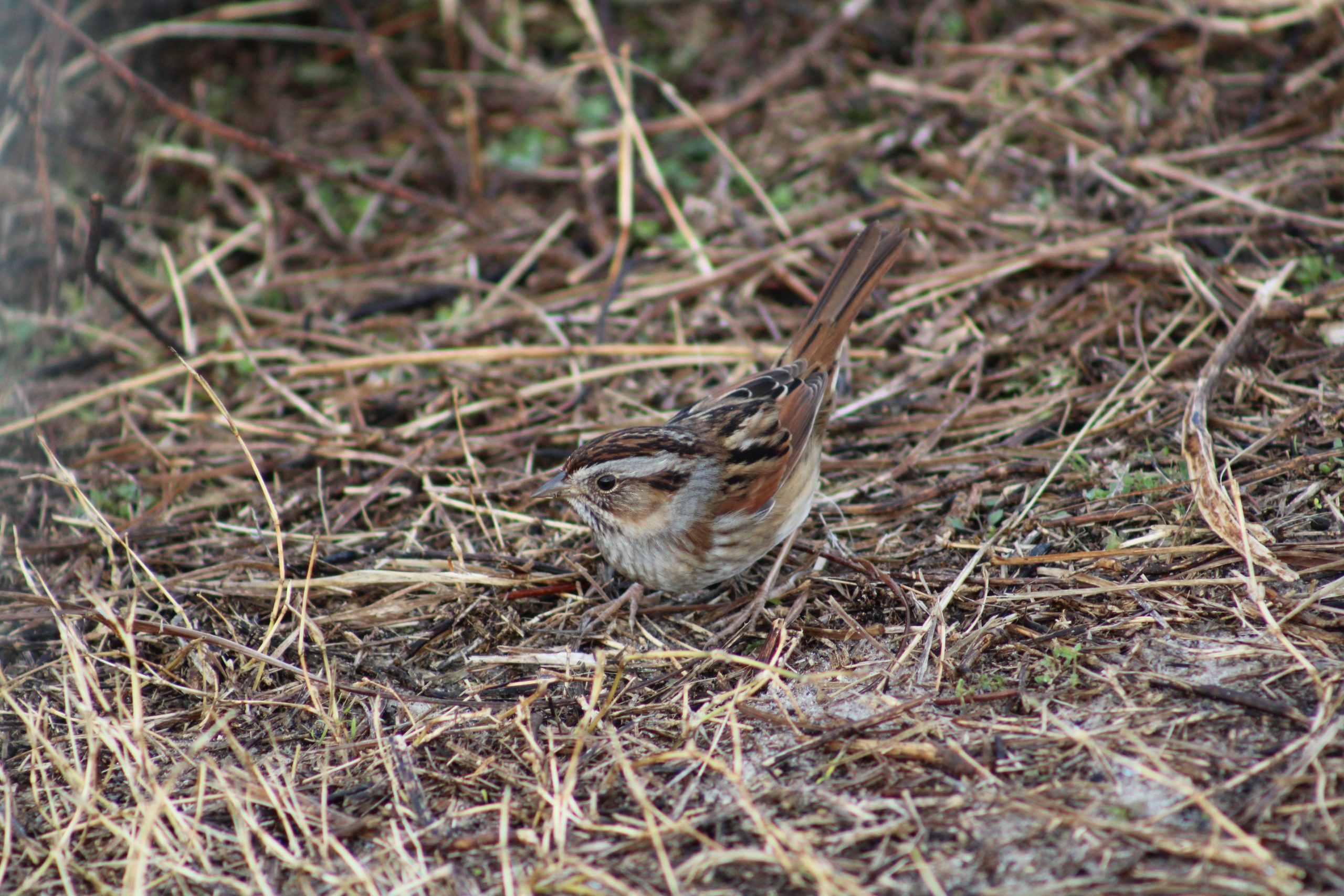The House Sparrow (Passer domesticus) is one of the most common birds on the planet. With the ability to thrive in made-made habitats, like bustling cities, these sparrows have spread around the world. But where do these birds nest? We will explore how sparrows nest and you’ll walk away from this read with everything you’ve wanted to know about the nest of a sparrow.
Key facts:
- House Sparrows tend to nest near humans. But tuck their nests into an out-of-sight location.
- Typically, they like enclosed spaces like holes. Dense vegetation can also work.

Nest of a Sparrow
When you look at the bird’s nest, it can be difficult to tell what kind of bird it belongs to. Here’s what you need to know about House Sparrow nests.
Nest of a Sparrow: Location
House sparrows are small, gregarious birds that prefer living in urban and suburban environments. In general, these small birds exploit human structures for nesting purposes. House sparrows display a notable preference for nooks and crannies in buildings, particularly under eaves, in roof spaces, and even in the crevices of walls. Their resourcefulness extends to utilizing ledges, and gutters, showcasing their adeptness at navigating and exploiting the man-made landscape.
I’ve even caught a house sparrow trying to build a nest in my door hanger! When I came home late one night, it flew out at me while trying to unlock the door. I’m sure it was quite a shock for both of us. Other sub-par nesting locations include traffic lights and dryer vents.
In addition to urban locales, house sparrows also demonstrate a proclivity for nesting in agricultural areas. Barns, sheds, and other farm structures provide suitable nesting opportunities, allowing these birds to establish their homes in close proximity to potential food sources. This adaptability underscores the house sparrow’s resilience in coexisting with human activities, making them a common sight in a wide range of habitats shaped by human influence.
If human structures aren’t an option, House Sparrows can make due with dense vegetation.
Nest of a Sparrow: Size
House sparrow nests typically measure around 6 to 7 inches in diameter, emphasizing the birds’ preference for creating snug enclosures. The construction process involves the adept interweaving of various materials, including twigs, grasses, and feathers, resulting in a sturdy and well-insulated structure.
Nest of a Sparrow: Construction

The responsibility for building falls primarily on the female, who engages in a meticulous process that showcases both skill and resourcefulness. With an active and purposeful demeanor, female house sparrows gather an assortment of materials, including twigs, grasses, feathers, and even bits of human-made debris.
In the active phase of construction, the female deftly weaves and interlaces these materials to form a sturdy and compact structure. The process involves a series of deliberate actions, from selecting appropriate nesting sites, often in the nooks and crannies of buildings or trees, to the meticulous arrangement of materials to create a cozy interior.
It usually only takes a house sparrow a couple of days to build a nest that’s ready for a family.
Nest of a Sparrow: Appearance
House sparrow nests typically take on a rounded or domed shape with a side entrance. Upon closer inspection, the interior of house sparrow nests reveals a softer lining, often consisting of feathers, hair, or other fine materials. This lining enhances the nest’s insulation properties, providing a cozy and comfortable environment for incubating eggs and raising chicks.
Do House Sparrows Use Nest Boxes?
When presented with suitable nest boxes, house sparrows actively investigate and may choose them as secure locations for building their nests. Nest boxes, strategically placed in urban or suburban areas, often facilitates the coexistence of these birds with human communities.
The active adoption of nest boxes by house sparrows highlights their opportunistic nature and the capacity to thrive in close association with human habitats.
What Time of Year Do House Sparrows Nest?
As the temperatures rise and daylight hours lengthen, typically from late March through early August, house sparrows enter their breeding season. But house sparrows living in warmer locales might enjoy an extended nesting season, as long as January to October.
The timing aligns with the availability of insects and vegetation, crucial resources for sustaining both the adults and their soon-to-be-hatched chicks.
How Long Do House Sparrows Nest?
The nesting season for house sparrows includes early spring through late summer. Throughout the season, house sparrows can have multiple broods. Here’s a breakdown of the nesting timeline:
- Make nest: Usually takes just a few days.
- Egg laying: One to eight days.
- Incubation: 10 to 14 days.
- Fledging: 10 to 16 days.
After the brood leaves the nest, the parents can start working on another brood. They reuse the nest from brood to brood.
What Month Do House Sparrows Lay Eggs?
The exact timeframe of laying eggs varies from location to location. But in the United States, house sparrows tend to lay eggs between March and September. In the United Kingdom, the timeline is usually April to August. In warmer locations, the nesting season could stretch from January to October.
House Sparrow Eggs
The eggs are the whole point of building a nest. Below is more information about these important things.
How Many Eggs Do Sparrows Lay?
The female sparrow typically lays between four to seven eggs in a single clutch, with the average number hovering around five or six.
The clutch size of house sparrows can change due to fluctuations in food availability and environmental factors. The eggs are typically laid in quick succession, usually one egg per day. The female then invests her energy in incubating the eggs to ensure a successful hatching.
What Do Sparrow Eggs Look Like?
Typically, house sparrow eggs are small and oval-shaped. The shell of a house sparrow egg is smooth and possesses a subtle sheen, showcasing a pale background color with variations that may include shades of white, cream, or brown. Many house sparrow eggs have fine speckles or markings.
Which Parent Sits On The Eggs?
In the realm of house sparrows, the responsibility of incubating eggs falls primarily on the female. Once the female actively lays the eggs, she assumes an attentive and nurturing role, actively sitting on the clutch to provide warmth and facilitate the crucial process of embryonic development. This active incubation period typically lasts for about 10 to 14 days, during which the female maintains a consistent and dedicated presence on the nest.
The male, on the other hand, plays a supportive role by providing food for the incubating female. And in a pinch, the male can sit on the eggs.
How Many Clutches Do Sparrows Have?
House sparrows are prolific breeders, often raising multiple broods within a single breeding season. Their active reproductive strategy allows them to produce several sets of offspring each year. Typically, house sparrows can have two to four broods annually, although the exact number may vary depending on environmental factors, food availability, and regional climate conditions.
How Long Do Baby Sparrows Stay In The Nest?
House sparrow chicks spend about 10 to 16 days in the nest, depending on factors such as environmental conditions, food availability, and individual variations. For example, if there is less food available, it might take longer for the chicks to fledge. During this period, both parents play an active role in caring for and feeding the chicks, ensuring their growth and development.
House Sparrow Range
The tiny birds have followed humans across the world. Originally native to the Middle East and Eurasia, these adaptable birds have successfully expanded their range through human-mediated introductions. Active human settlements, including urban areas, agricultural landscapes, and suburban environments, provide ideal conditions for house sparrows. Their range extends from cities and towns to farmlands and open countryside, showcasing an active and widespread distribution.
In the mid-19th century, the songbird made it across the pond to take root in the United States. Since their introduction, these birds have colonized the entire nation. With the large range, it’s not uncommon to see house sparrows everywhere you go. (especially if you live in an urban area.)
Nest of a Sparrow: Frequently Asked Questions
Should I destroy a house sparrow nest?
House sparrows are a common species that often nest in and around human structures. If the nest is causing issues or poses a risk, it’s recommended to wait until the nesting season is over. But since house sparrows are so common, you’ll likely be able to remove the nest without violating any laws.
Can I remove a House Sparrow Nest?
You can likely remove a house sparrow nest. But before taking any action, it’s important to check local regulations and consider alternatives to removal, such as preventing access to the nesting site or installing barriers. If removal is absolutely necessary, it’s advisable to consult with local wildlife authorities or conservation organizations for guidance.
Why are House Sparrows bad?
House sparrows are not inherently “bad,” but they can sometimes be considered pests due to their adaptability to urban environments and potential for nesting in inconvenient locations. They may compete with native bird species for resources and nesting sites.
What trees do sparrows nest in?
While they commonly nest in man-made structures like buildings and nest boxes, they also use trees for nesting. Usually, they’ll opt for dense vegetation, like an evergreen tree.
How do you make a sparrow nest?
You cannot build a sparrow nest. But you can build a nesting box with the intention of providing a home to nesting birds. For example, you could purchase this nesting box on Amazon.
